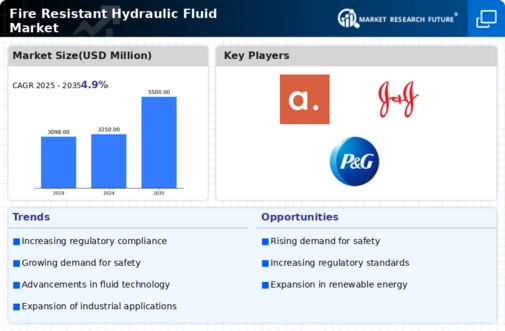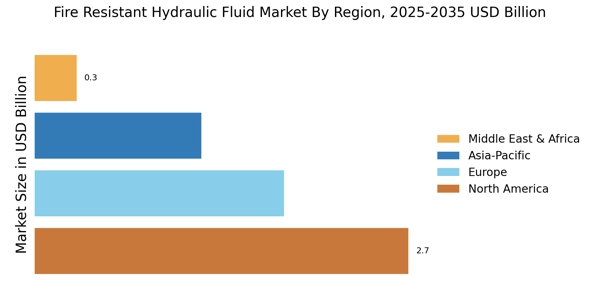Sustainability and Eco-Friendly Solutions
The growing emphasis on sustainability is significantly impacting the Fire Resistant Hydraulic Fluid Market. As industries strive to reduce their environmental footprint, there is an increasing demand for eco-friendly hydraulic fluids that do not compromise on performance. Manufacturers are responding to this trend by developing biodegradable and non-toxic fire-resistant hydraulic fluids. These products not only meet safety standards but also align with corporate sustainability goals. The market for environmentally friendly hydraulic fluids is expected to grow at a rate of 6% annually, reflecting a shift in consumer preferences towards sustainable solutions. This trend is likely to reshape the competitive landscape of the fire-resistant hydraulic fluid market, as companies that prioritize sustainability may gain a competitive edge.
Regulatory Compliance and Safety Standards
The Fire Resistant Hydraulic Fluid Market is increasingly influenced by stringent regulatory compliance and safety standards. Governments and regulatory bodies are imposing rigorous guidelines to ensure the safe use of hydraulic fluids, particularly in industries such as aerospace, manufacturing, and construction. These regulations often mandate the use of fire-resistant fluids to mitigate risks associated with flammable hydraulic fluids. As a result, companies are compelled to adopt fire-resistant hydraulic fluids to comply with these regulations, thereby driving market growth. The market for fire-resistant hydraulic fluids is projected to reach USD 1.5 billion by 2026, reflecting a compound annual growth rate of approximately 5.2%. This trend indicates a growing recognition of the importance of safety in industrial operations, further solidifying the role of fire-resistant hydraulic fluids in various applications.
Increased Industrialization and Urbanization
The ongoing trends of industrialization and urbanization are driving the Fire Resistant Hydraulic Fluid Market. As countries continue to develop their infrastructure and industrial capabilities, the demand for hydraulic systems in construction, manufacturing, and transportation is on the rise. This increased industrial activity necessitates the use of fire-resistant hydraulic fluids to ensure safety and compliance with regulations. For example, the construction sector alone is projected to grow by 4% annually, leading to a heightened demand for hydraulic fluids that can withstand high temperatures and prevent fire hazards. Consequently, the fire-resistant hydraulic fluid market is expected to benefit from this industrial growth, as more companies seek reliable and safe hydraulic solutions.
Growing Awareness of Fire Safety in Industries
There is a notable increase in awareness regarding fire safety across various industries, which is positively influencing the Fire Resistant Hydraulic Fluid Market. Companies are becoming more cognizant of the potential risks associated with flammable hydraulic fluids, leading to a proactive approach in adopting fire-resistant alternatives. This heightened awareness is particularly evident in sectors such as oil and gas, mining, and manufacturing, where the consequences of fire incidents can be catastrophic. As a result, organizations are investing in fire-resistant hydraulic fluids to enhance safety measures and protect their assets. The market is expected to see a surge in demand as industries prioritize fire safety, potentially leading to a market valuation of USD 1.8 billion by 2027.
Technological Advancements in Fluid Formulations
Innovations in fluid formulations are playing a pivotal role in the Fire Resistant Hydraulic Fluid Market. Recent advancements in chemical engineering have led to the development of more efficient and effective fire-resistant hydraulic fluids. These new formulations not only enhance fire resistance but also improve performance characteristics such as viscosity, thermal stability, and lubricity. For instance, the introduction of synthetic esters and phosphate esters has shown promising results in enhancing the fire resistance of hydraulic fluids. The market is witnessing a shift towards these advanced formulations, which are expected to account for a significant share of the market by 2025. This technological evolution is likely to attract investments and research initiatives aimed at further improving the safety and efficiency of hydraulic systems.


















Leave a Comment